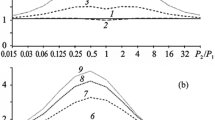Abstract
Correlation analysis of low-frequency reverberation signals has been carried out by decomposing the reverberation into reference functions, formed as a set of signals reflected from a point scatterer moving along a circular trajectory. The choice of the reference signal is related to the model of sound scattering by inhomogeneities (bubbles) occurring in the near-surface layer and moving together with the orbital currents of wind waves. The study demonstrated that the correlation functions differ significantly (by 5–6 dB) for the region of position and negative Doppler frequencies of reverberation signals. A stable increase has been revealed for the maximum of the correlation function at certain radii of scatterer motion, which are related to the amplitudes of wind waves.









Similar content being viewed by others
Notes
Generally speaking, integration over time from the product of a random signal multiplied by a deterministic time function, depending on one or two parameters, should be called generalized spectral analysis or signal decomposition into certain basis functions. However, a reader automatically understands “generalized spectral reverberation analysis” as decomposition of a reverberation signal into harmonic functions and not into anything else. Therefore, it was somewhat incorrect to call the operation correlation without reference to spectral analysis.
The scattering strength is the squared amplitude of the reflected field brought to a distance of 1 m from the scatterer normalized to the squared amplitude of the incident field.
To simplify calculations, let us consider the values of the wind wave period T and amplitude R0 as fixed. The mean wind wave amplitude based on the Pierson–Moskowitz spectrum at a frequency of 0.1 Hz is 1 m.
The surface area S from which a scattered signal reaches the receiving array is determined by the expression S =
 where C is the sound speed, t is the time delay of pulse arrival, ∆α is the width of the receiving array’s directivity diagram in the horizontal plane (rad), and τ is the pulse duration.
where C is the sound speed, t is the time delay of pulse arrival, ∆α is the width of the receiving array’s directivity diagram in the horizontal plane (rad), and τ is the pulse duration.
REFERENCES
B. M. Salin, O. N. Kemarskaya, P. A. Molchanov, and M. B. Salin, Acoust. Phys. 63 (3), 338 (2017).
B. M. Salin and M. B. Salin, Acoust. Phys. 64 (2), 196 (2018).
P. A. Kolobaev, Okeanologiya 15 (2), 1013 (1975).
T. H. Neighbors and L. Bjerne, Hydroacoustics 4, 181 (2001).
S. A. Thorpe, Philos. Trans. R. Soc., A 304, 155 (1982).
V. V. Shuleikin, Physics of Sea (Nauka, Moscow, 1968) [in Russian].
A. H. Perry and J. M. Walker, Ocean-Atmosphere System (Prentice Hall Press, 1977; Gidrometeoizdat, Leningrad, 1979).
I. R. Young, Coastal Eng. 57 (1), 30 (2010).
B. M. Salin and M. B. Salin, Izv. Vyssh. Uchebn. Zaved., Radiofiz. 58 (3), 200 (2015).
ACKNOWLEDGMENTS
Work on the section “Calculating the Expected Values and Structure of Correlation Functions” was supported by the Scientific Research Foundation of State Academies of Science for 2013–2020, section no. 12.18 “Development of Physical Foundations of New-Generation Acoustic Systems.” Work on the section “Correlation Analysis of Marine Reverberation Signals” was supported by the Russian Science Foundation (grant no. 14-17-00667).
Author information
Authors and Affiliations
Corresponding author
Additional information
Translated by A. Carpenter
Rights and permissions
About this article
Cite this article
Salin, B.M., Kemarskaya, O.N. & Salin, M.B. Estimating the Amplitude of Wind Waves by Correlation Analysis of the Reverberation Signal. Acoust. Phys. 65, 41–51 (2019). https://doi.org/10.1134/S1063771019010093
Received:
Revised:
Accepted:
Published:
Issue Date:
DOI: https://doi.org/10.1134/S1063771019010093





 where C is the sound speed, t is the time delay of pulse arrival, ∆α is the width of the receiving array’s directivity diagram in the horizontal plane (rad), and τ is the pulse duration.
where C is the sound speed, t is the time delay of pulse arrival, ∆α is the width of the receiving array’s directivity diagram in the horizontal plane (rad), and τ is the pulse duration.